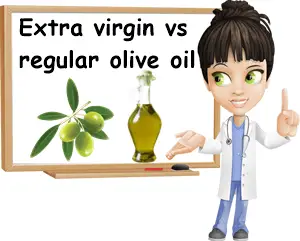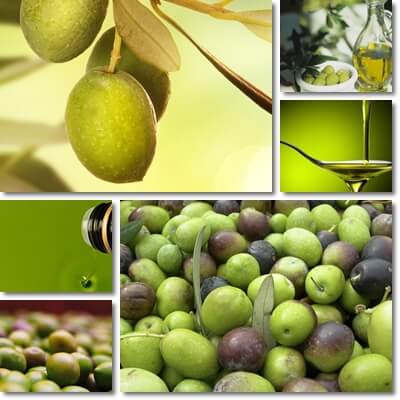Olive oil is best known for its benefits for cardiovascular health and as a functional food associated with better general health and even increased longevity. But there are quite a few different types of olive oil and not all have the same benefits for health, or even uses for that matter. While extravirgin olive oil is definitely the best of all the different types of olive oil in terms of health benefits, what are the differences between extravirgin vs what is labeled simply as olive oil? Keep reading to find out how to understand the difference between extravirgin and regular olive oil and how to choose a good olive oil for you.
What is extravirgin olive oil?
Extravirgin olive oil is the highest of all grades of olive oil. It is minimally processed, cold-pressed, first-press, fresh olive oil. It may be filtered or unfiltered, although most commercially available extravirgin olive oil is currently filtered for a more marketable look. It is made from freshly picked olives that are pressed for oil in roughly half an hour after being harvested.
Only the best-looking olives are chosen for making extravirgin olive oil, and should be without blemishes, mold, rot or mechanical or insect damage. The resulting oil will also look the part, hence the importance of raw material quality. Extravirgin olive oil, whether filtered or unfiltered, should have a free acidity content of up to 0.8%, this being a fundamental characteristic of highest-grade olive oils.

What is olive oil?
Regular olive oil, labeled simply as olive oil, may be a lot of different things, just not extravirgin. Unless the label specifies your olive oil is extravirgin, it’s not. Because extravirgin olive oil commands the highest price of all grades and because international legislation requires producers to be transparent about the nature and quality of their products (i.e. grade), the label will definitely say if your olive oil is extravirgin. Sometimes it says it is even if it isn’t (read up on the fake olive oil scandal from recent years).
So if it’s not labeled as extravirgin, your olive oil definitely isn’t. But what is it then? While it should say clearly on the label what a product is, sometimes the label is either purposefully omitting information or is just too confusing if you’re not up to date with legislation or haven’t been using a type of product for long enough to have a better understanding of its grades or quality. If your label says just olive oil, then it’s likely what is known as pure olive oil.
What is pure olive oil?
Most of the time, if your olive oil is labeled simply as ‘olive oil’, it’s pure olive oil. That could mean it’s 100% refined olive oil, or a mix or blend of mostly refined olive oil with smaller amounts of higher-grade types of olive oil such as virgin olive oil or, more rarely, extravirgin. Adding higher-grade types is done to improve the flavor and color of the product lost as a result of refining processed such as bleaching and deodorization.

Extravirgin olive oil vs regular olive oil
- Free acidity content difference
Extravirgin olive oil has a free acidity content of up to 0.8% vs regular olive oil which has a free acidity of 0.3% (if it’s 100% refined). If it’s a blend of refined and virgin or, more rarely, extravirgin, the free acidity content is variable, but still low, considering that regular olive oil is mostly refined olive oil which is low in acidity anyway (statistically, it’s about 85% refined and only about 15% virgin or extravirgin).
- Cold-processed vs solvent and heat-processed
Extravirgin olive oil is minimally processed, that is, the fruits are crushed (cold-pressed) and the impurities filtered out. Vs extravirgin, regular olive oil is much more processed: an initially minimally-processed, but (usually defective) virgin olive oil or inedible lampante is refined using solvents and heat processing to produce a refined olive oil version which is then marketed as olive oil, sometimes with the addition of minimal amounts of virgin or extravirgin olive oil for color or flavor. Find out what are the 7 types of olive oil by quality.
- Uses: fresh vs for cooking
Extravirgin olive oil is preferred fresh, both for consumption and cosmetic uses, but can be used for light cooking too (its smoke point is 190-215 degrees Celsius so anything less than deep-frying is still healthy). Versus regular olive oil which is either entirely or mostly refined, and preferred for cooking due to both a lower-grade flavor which does not shine when used fresh and higher heat-stability, although a similar smoke point to extravirgin (about 210 degrees Celsius). Because the processing undergone also removes healthful components such as fatty acids, vitamin E, vitamin K, polyphenols and other antioxidants, olive oil that is not extravirgin is not preferred or suitable for skin care and other at-home cosmetic uses.
- Taste intensity and flavor profile
Extravirgin olive oil is extremely flavorful, with green, grassy flavor notes, sometimes also fruity notes if the olives are riper. The oil also tastes slightly bitter, peppery even, and overall refreshing, with a smell reminiscent of fresh olives. Compared to it, olive oil that is 100% refined, or even blended with limited amounts of virgin or, more rarely, extravirgin, cannot provide the whole range of flavors represented in extravirgin grades, or any flavor at all except for some degree of oiliness. This is because during the refining process, the oil is bleached and deodorized which remove most or as much of the color, flavor and odor as possible.
- Color variation
Extravirgin olive oil has either a beautiful golden color, often with green reflexes, or a strong green tinge. Its color stands out beautifully on a white plate or white bread. Versus regular olive oil which has a light amber color, almost clear, and looks like a refined sunflower seed oil. As part of the refining process, the oil is bleached and deodorized to remove pigment, odor and flavor. The only reason why it’s also mixed with smaller amounts of virgin or, more rarely, extravirgin olive oil later on is to give it a color and flavor that are more appealing to consumers.
- Sub-classifications by quality
Extravirgin olive oil is sometimes divided into Premium and simply Extravirgin Olive Oil, although this is not common since it’s a premium oil as it is; vs regular olive oil which is more commonly divided into several sub-classes by quality or composition. For example, olive oil labeled as Pure Olive Oil or Classic Olive Oil is a blend of mostly refined olive oil and small amounts of virgin or, more rarely, extravirgin olive oil. Then there are the Light Olive Oil and Extra-Light Olive oil which are not lower-calorie as their names might suggest, but rather more refined, meaning they lack even more flavor, color and odor. However, this is not a common practice in countries where olive oil is consumed on a large scale.
Conclusion
Exact appearance of olive oil, color, smell, taste and flavor profile, as well as fatty acids composition (types of fat in olive oil and their content) will be determined by the variety of olives that serve as raw material, their ripeness at the time of harvest, weather conditions leading up to the crop harvest, individual fruit health, region and altitude of olive trees sourced for their fruit, extraction method and degree of processing undergone. So there may be some minor differences between the different types of olive oil pertaining to the same grade. This is to be expected. However, it does not create any confusion between high-grade, extravirgin and lower-grade, refined olive oil types since the difference in quality between the two is generally fairly known to most, if not all consumers.
